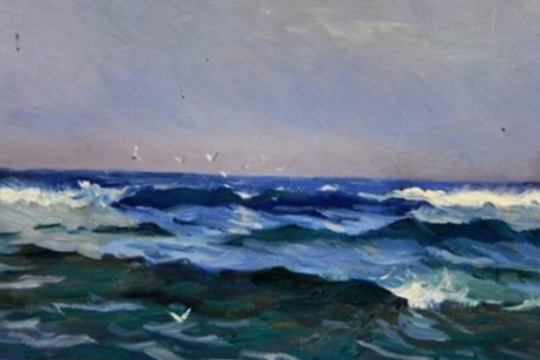Historical information
Used to communicate with ships from Point Hicks Lightstation. In Greek mythology, "Stentor" was a herald on the Greek side during the Trojan War. His name has given rise to the adjective "stentorian", meaning loud-voiced, for which he was famous. Homer said his "voice was as powerful as fifty voices of other men." He died after his defeat by Hermes in a shouting contest. See the Iliad, V.
The large funnel-shaped device is nearly 750mm (30 inches) in length and is made of re coated cardboard that is riveted together. It has a metal mouth-piece at the narrow end and a metal edge at the wide end, and a metal handle. The maker’s information inside indicates that it is a ‘Stentor Megaphone’ patented on 4 April 1899 by a company in Boston. Stentor brand megaphones were manufactured by Merriman Brothers, a firm established in Boston
in 1898 specializing in hardware for yachts. Merriman Bros. Manufacturers. 139 Border St. East Boston, Mass. Their equipment, which included pulley blocks, winches and fittings, was well-known worldwide before the company closed in about
1995. However, their ‘main business was not blocks and winches’…‘it was Merriman megaphones, including the familiar cheerleader megaphones’. They came in different sizes, one of which was employed by the United States Navy because of its scientifically proven horn angle of 22 degrees’. Their patent for the device, dated April 4, 1899, specified details such as the ‘rivets, metal mouthpiece, and adjacent parts’,and an undated pamphlet promoting the Stentor Megaphone emphasizes its ‘highly finished’ appearance ‘with nickel mouthpiece, rim and other fittings’. It also pronounces ‘the carrying power of a Megaphone is astonishing. Even under adverse conditions, it magnifies the power of the voice many times. For listening to distant sounds, it is also of great assistance’. Various sizes were designed for particular uses, and the pamphlet advises that the 30 inch no.2 model, which cost US $2.50, ‘makes it easy to talk half-a-mile and shout a mile’. An advertisement also stresses that it has ‘no iron parts’, making it ideal for marine situations.The Penobscot Marine Museum, Searsport, Maine, United States, has the same or similar model of megaphone in its collection, and the Flagstaff Hill Maritime Village Museum, Warrnambool, Victoria, has a galvanised metal ‘Acme Stentor’ megaphone.
Significance
The Point Hicks Stentor Megaphone has first level contributory significance for its provenance and historic value, and also as a relatively rare item of equipment once used worldwide in marine situations, such as lightstations, as demonstrated by this example in a Victorian lightstation.
Physical description
One large funnel shaped megaphone made of coated cardboard riveted together. Has a metal handle and metal rims at each end. Dark reddish brown colour.
Inscriptions & markings
"No 2 / THE / STENTOR MEGAPHONE / PATENTED APRIL 4TH 1899 / .../ MAKERS / .OSTON. MASS"





